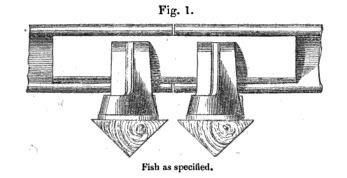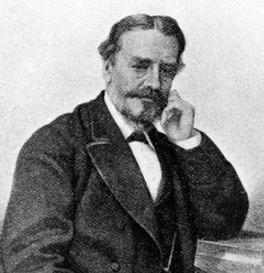Name William Adams | Role Author | |
 | ||
Books English Pleasure Carriages: Their Origin, History, Varieties, Materials, Construction, Defects, Improvements, and Capabilities: with an Analysis of the Construction of Common Roads and Railroads, and the Public Vehicles Used on Them; Together with Descriptions of New Inventions ... | ||
William Bridges Adams (1797 – 23 July 1872) was an author, inventor and locomotive engineer. He is best known for his patented Adams axle — a successful radial axle design in use on railways in Britain until the end of steam traction in 1968 — and the railway fishplate. His writings, including English Pleasure Carriages (1837) and Roads and Rails (1862) covered all forms of land transport. Later he became a noted writer on political reform, under the pen name Junius Redivivus (Junius reborn); a reference to a political letter writer of the previous century.
Contents

Personal life
He was born and grew up in Woore, Shropshire, close to Madeley, Staffordshire and was educated at the Madeley School. His father was a son of a yeoman farmer of Woore, who moved to London where he worked his way from a journeyman to master. His principal business was that of supplying leather to coachmakers from a shop in Dean Street, Soho. In due course Adams was apprenticed to the coach making firm of Baxter & Pierce of Long Acre, London. This was a well known firm and during his time with the company Napoleon's travelling carriage was brought there, after the battle of Waterloo, and Bridges Adams made a drawing of it.
In December 1819 he married Elizabeth Place, the daughter of Francis Place, the social reformer. Together they set out on a voyage to find their fortunes in a warmer climate. In 1820 they left for Valparaiso in Chile. In Valparaiso he was employed to manage Lord Cochrane's estate, for a salary of £200 per year. In 1821 he had a son, William Alexander Adams. The family survived the earthquake in Valparaiso of 19 November 1822. Elizabeth died on 8 August 1823, when giving birth to a second child, who also died. Following this tragedy Bridges Adams returned to England, with his son, by a long trek over the Andes to Buenos Aires and by ship back to London, via Falmouth, in 1826. After a further trip to the United States, Bridges Adams settled in London and took a position in the firm of Hobson & Co, Coachmakers.
Marriages
Adams was married three times. His first wife was Elizabeth Place. He married Sarah Fuller Flower Adams in 1834 and they resided at the now demolished Sunnybank, Woodbury Hill, in Loughton, where there is a blue plaque to the couple jointly. After Sarah's death in 1848, he remarried to Ellen Kendall, with whom he would have one daughter, Hope Bridges Adams.
Later life
Adams died at Cuthbert House, Broadstairs, Kent, aged seventy-five, and was buried at St Peter's Church in the town.
Railway engineering
Bridges Adams patented an improved carriage spring, which he called "bow springs". These could also be used on railway carriages, and the manufacture proved profitable. The manufacture was based in the Currier Factory in Drury Lane and Parker Street, Soho. The business was carried out in the name of Samuel Adams, Bridges Adams's uncle. In 1842 the factory moved from its small premises to three acres of land adjoining the Eastern Counties Railway at Fair Field, Bow. The company now traded as Adams & Co. He founded the Fairfield Locomotive Works (51°31′52″N 0°01′19″W) in Bow, East London, in 1843, where he specialized in light engines, steam railcars (or railmotors) and inspection trolleys. These were sold in small numbers to railways all over Britain and Ireland, including the Fairfield steam carriage for the broad gauge Bristol and Exeter Railway and the Enfield for his most important customer, the Eastern Counties Railway, with its headquarters at nearby Stratford. Dissatisfied with the scarf joints then in use for joining iron track, he invented the first railway fishplate, in the form of an unbolted wedge between adjoining chairs, in collaboration with Robert Richardson, a junior engineer under Peter Bruff on the Eastern Counties Railway. The two men patented the invention in 1847. Although the design was successful, with sales to the Eastern Counties Railway among others, financial difficulties forced Adams to relinquish the patent. This "wedge" version was soon overtaken by an improved, bolted design by James Samuel of the Eastern Counties Railway. He also supplied an 2-2-0 well tank to the Roman Railway.
Although Adams’s inventions and writings became well-known, the locomotives he produced made little impact. The engineering business failed some years later, although by this time Adams had expanded his interests to include clothing design and journalism.
Confusion with William Adams
Confusingly, one of the first railway companies to use his axle-box design widely was the London and South Western Railway where the Locomotive Superintendent, the creator of the Adams Bogie, was also named William Adams. By further coincidence he too had formerly operated a locomotive works in Bow, but this was not a private concern but the depot of the North London Railway. In 1865 the Society of Engineers, London, made direct comparison between the bogie with the india-rubber lateral bearing of William Adams and the radial axle box of William Bridges Adams: during trials on the North London Railway the laterally sprung bogie was thought superior to the radial axle, but when William Adams moved to the LSWR he adopted the axle box designed by his rival Bridges Adams. The locomotives now known as Adams Radials are named after the Locomotive Superintendent, but they are famous for the axle invented by William Bridges Adams.
